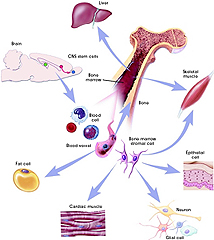The birth and death of cells are key
functional aspects of many tissues and organs and an understanding
and recognition of cells undergoing mitosis and death is important
in histology. We have examined mitotic cells earlier but will do so
again briefly here, concentrating on their context and tissue
location as “stem cells” for that or other tissues. We will also
look for and examine cells undergoing regulated or “scheduled” cell
death. Such apoptotic cells must be distinguished from necrotic
cells, which die following physical or toxic injury of some kind.
The effects on the tissue of the two kinds of cell death could not
be more different.
Learning Objectives
- To be able to recognize and
understand the context for various examples of stem cells
(“adult stem cells’)
- To consider stem cells in terms
of the cell cycle, tissue renewal and repair, cancer, and
apoptosis
- To understand the biology of
apoptosis and to recognize cells undergoing apoptosis in certain
tissues
Stem cells are relatively
undifferentiated cells which slowly divide in many tissues (most
prominently in the bone marrow, epidermis and gut lining) throughout
an individual’s lifetime, producing a continuous supply of new stem
cells and a new population of cells that replaces the specialized
dying cells in that tissue. Click image to the right for
expanded
view of stem cell populations.
- As examples of stem cells, again
look for and examine the mitotic cells in crypts of the
epithelial lining of the small intestine (slide 37). Also
examine bone marrow of slide 34 and identify large cells with
very basophilic nuclei which are stem cells for various types of
blood cells (to be studied later).
Can you offer a reason why stem
cells usually have basophilic nuclei and are rather
undifferentiated?
Apoptosis |